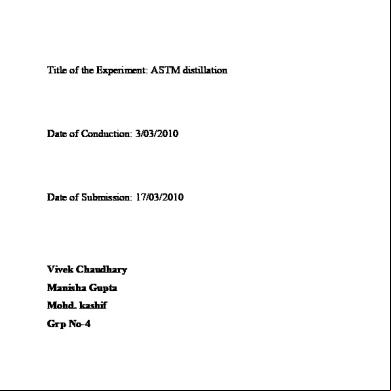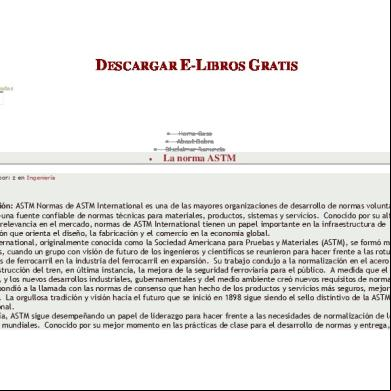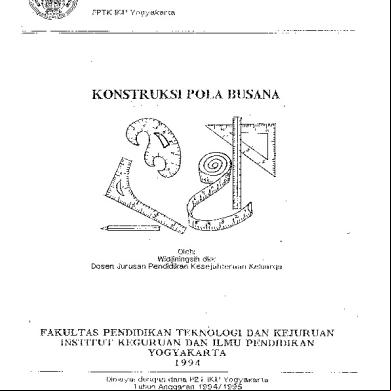Astm D646-13 Grammature 154e54
This document was ed by and they confirmed that they have the permission to share it. If you are author or own the copyright of this book, please report to us by using this report form. Report 3b7i
Overview 3e4r5l
& View Astm D646-13 Grammature as PDF for free.
More details w3441
- Words: 1,328
- Pages: 2
Designation: D646 − 13
Standard Test Method for
Mass Per Unit Area of Paper and Paperboard of Aramid Papers (Basis Weight)1 This standard is issued under the fixed designation D646; the number immediately following the designation indicates the year of original adoption or, in the case of revision, the year of last revision. A number in parentheses indicates the year of last reapproval. A superscript epsilon (´) indicates an editorial change since the last revision or reapproval. This standard has been approved for use by agencies of the Department of Defense.
1. Scope
4. Significance and Use
1.1 This test method covers the determination of the mass per unit area of paper and paperboard.
4.1 Most paper is bought and sold in accordance with its mass per unit area, and therefore has great significance both to the consumer and the producer in defining price. Also, the values of many physical properties such as bursting strength, thickness, and bulk are interpreted and specified with regard to the particular mass per unit area involved.
1.2 In the SI metric units system, the mass per unit area of paper and paperboard is expressed in grams per square meter (g/m2). 1.3 The values stated in SI units are to be regarded as standard. No other units of measurement are included in this standard. 1.4 This standard does not purport to address all of the safety concerns, if any, associated with its use. It is the responsibility of the of this standard to establish appropriate safety and health practices and determine the applicability of regulatory limitations prior to use. 2. Referenced Documents 2.1 ASTM Standards:2 D123 Terminology Relating to Textiles D685 Practice for Conditioning Paper and Paper Products for Testing D1776 Practice for Conditioning and Testing Textiles 3. Summary of Test Method 3.1 The area of several sheets of the paper or paperboard is determined from linear measurements and the mass is determined by weighing. The test-result is calculated from the ratio of the mass to the area.
5. Apparatus 5.1 Weighing Device, readable and accurate to within 0.25 % of the applied load. When in use, the weighing device shall be shielded from air currents. 5.2 Cutting Device, such as a “four square” cutter, or other device for ensuring right angles between the edges. 5.2.1 When a template is used for preparing test specimens, the paper should be cut to exact size with a sharp knife on a hard surface, such as a hardwood board. 5.3 Scale, such as a finely graduated steel rule reading in 0.5 mm, capable of measuring the dimensions of the test specimen to an accuracy of 0.2 %. 6. Sampling 6.1 Sampling shall be consistent with documented internal practices as agreed upon between sellers and buyers before purchase. 6.2 From each test unit of the sample, cut a sheet with a dimension of 200 6 5 × 200 6 5 mm. 7. Calibration
1
This test method is under the jurisdiction of ASTM Committee D13 on Textiles and is the direct responsibility of Subcommittee D13.19 on Industrial Fibers and Metallic Reinforcements. Current edition approved July 1, 2013. Published August 2013. Originally approved in 1941. Last previous edition approved in 2007 as D646–96 (2007) which was withdrawn February 2010 and reinstated in July 2013. This test method is related to TAPPI T 410 om-13, which is technically identical, and is similar to International Standard ISO 536, Paper and Board—Determination of Grammage. DOI: 10.1520/D0646-13. 2 For referenced ASTM standards, visit the ASTM website, www.astm.org, or ASTM Customer Service at [email protected]. For Annual Book of ASTM Standards volume information, refer to the standard’s Document Summary page on the ASTM website.
7.1 Checking of Weighing Device: 7.1.1 Check the accuracy of the weighing device frequently (7.3) by applying accurately measured masses with both increasing and decreasing loads. When using a sheet-weighing device, be sure that the device has been properly calibrated to the required accuracy (5.1). 7.1.2 Before each use, see that frictional effects are sufficiently minimal and that the zero reading is sufficiently correct as to ensure the required weighing accuracy. 7.2 Checking of Cutting Device—Frequently (7.3) check the cutting by using the scale (5.3) to measure the lengths of the
Copyright © ASTM International, 100 Barr Harbor Drive, PO Box C700, West Conshohocken, PA 19428-2959. United States
Copyright by ASTM Int'l (all rights reserved); Wed Nov 16 04:58:14 EST 2016 1 ed/printed by Intertek Testing Services NA (Intertek Testing Services NA) pursuant to License Agreement. No further reproductions authorized.
D646 − 13 four sides of 20 test specimens. Accuracy is attained when the standard deviation of all lengths is less than 0.5 % of the mean length. 7.3 Frequency of Checking—The frequency of checking in 7.1 and 7.2 should be based on experience. A new device should be checked several times before being put into use. Then, if in continuous use, it should be checked twice daily until stability is established, then weekly, monthly, or less frequently as indicated by its stability, unless moved or unduly disturbed. Because of wear, the cutting device may require more frequent checking than the weighing device. 8. Conditioning 8.1 Condition and test the specimens in an atmosphere in accordance with Practice D1776 or D685, unless the “as received” value is required. 9. Procedure
BW 5
where: M = A = H = W = BW =
the the the the the
M M 5 A H·W
(1)
mass of the specimen, g, area of the specimen, m2, specimen height, m, specimen width, m, and mass per unit area (basis weight) in g/m2.
11. Report 11.1 Report the following information: 11.1.1 Testing conditions. 11.1.2 The actual total area tested. 11.1.3 The mass per unit area in grams per square meter. 12. Precision and Bias
9.1 Cut the specimen with the accuracy specified in 6.2. 9.2 Measure the height and width with the accuracy specified in 5.3. 9.3 Weigh each test specimen with an accuracy specified in 5.1.
12.1 The repeatability standard deviation from a single operator has been determined to be 0.94 %. 12.2 An interlaboratory study of this test method is being conducted and a complete precision statement is expected to be available on or before 2015.
10. Calculation 10.1 From the measurements, calculate the mass per unit area of each test specimen. The mass per unit area in grams per square meter is calculated by the equation:
13. Keywords 13.1 aramid paper; basis weight; mass per unit area
ASTM International takes no position respecting the validity of any patent rights asserted in connection with any item mentioned in this standard. s of this standard are expressly advised that determination of the validity of any such patent rights, and the risk of infringement of such rights, are entirely their own responsibility. This standard is subject to revision at any time by the responsible technical committee and must be reviewed every five years and if not revised, either reapproved or withdrawn. Your comments are invited either for revision of this standard or for additional standards and should be addressed to ASTM International Headquarters. Your comments will receive careful consideration at a meeting of the responsible technical committee, which you may attend. If you feel that your comments have not received a fair hearing you should make your views known to the ASTM Committee on Standards, at the address shown below. This standard is copyrighted by ASTM International, 100 Barr Harbor Drive, PO Box C700, West Conshohocken, PA 19428-2959, United States. Individual reprints (single or multiple copies) of this standard may be obtained by ing ASTM at the above address or at 610-832-9585 (phone), 610-832-9555 (fax), or [email protected] (e-mail); or through the ASTM website (www.astm.org). Permission rights to photocopy the standard may also be secured from the ASTM website (www.astm.org/ COPYRIGHT/).
Copyright by ASTM Int'l (all rights reserved); Wed Nov 16 04:58:14 EST 2016 2 ed/printed by Intertek Testing Services NA (Intertek Testing Services NA) pursuant to License Agreement. No further reproductions authorized.
Standard Test Method for
Mass Per Unit Area of Paper and Paperboard of Aramid Papers (Basis Weight)1 This standard is issued under the fixed designation D646; the number immediately following the designation indicates the year of original adoption or, in the case of revision, the year of last revision. A number in parentheses indicates the year of last reapproval. A superscript epsilon (´) indicates an editorial change since the last revision or reapproval. This standard has been approved for use by agencies of the Department of Defense.
1. Scope
4. Significance and Use
1.1 This test method covers the determination of the mass per unit area of paper and paperboard.
4.1 Most paper is bought and sold in accordance with its mass per unit area, and therefore has great significance both to the consumer and the producer in defining price. Also, the values of many physical properties such as bursting strength, thickness, and bulk are interpreted and specified with regard to the particular mass per unit area involved.
1.2 In the SI metric units system, the mass per unit area of paper and paperboard is expressed in grams per square meter (g/m2). 1.3 The values stated in SI units are to be regarded as standard. No other units of measurement are included in this standard. 1.4 This standard does not purport to address all of the safety concerns, if any, associated with its use. It is the responsibility of the of this standard to establish appropriate safety and health practices and determine the applicability of regulatory limitations prior to use. 2. Referenced Documents 2.1 ASTM Standards:2 D123 Terminology Relating to Textiles D685 Practice for Conditioning Paper and Paper Products for Testing D1776 Practice for Conditioning and Testing Textiles 3. Summary of Test Method 3.1 The area of several sheets of the paper or paperboard is determined from linear measurements and the mass is determined by weighing. The test-result is calculated from the ratio of the mass to the area.
5. Apparatus 5.1 Weighing Device, readable and accurate to within 0.25 % of the applied load. When in use, the weighing device shall be shielded from air currents. 5.2 Cutting Device, such as a “four square” cutter, or other device for ensuring right angles between the edges. 5.2.1 When a template is used for preparing test specimens, the paper should be cut to exact size with a sharp knife on a hard surface, such as a hardwood board. 5.3 Scale, such as a finely graduated steel rule reading in 0.5 mm, capable of measuring the dimensions of the test specimen to an accuracy of 0.2 %. 6. Sampling 6.1 Sampling shall be consistent with documented internal practices as agreed upon between sellers and buyers before purchase. 6.2 From each test unit of the sample, cut a sheet with a dimension of 200 6 5 × 200 6 5 mm. 7. Calibration
1
This test method is under the jurisdiction of ASTM Committee D13 on Textiles and is the direct responsibility of Subcommittee D13.19 on Industrial Fibers and Metallic Reinforcements. Current edition approved July 1, 2013. Published August 2013. Originally approved in 1941. Last previous edition approved in 2007 as D646–96 (2007) which was withdrawn February 2010 and reinstated in July 2013. This test method is related to TAPPI T 410 om-13, which is technically identical, and is similar to International Standard ISO 536, Paper and Board—Determination of Grammage. DOI: 10.1520/D0646-13. 2 For referenced ASTM standards, visit the ASTM website, www.astm.org, or ASTM Customer Service at [email protected]. For Annual Book of ASTM Standards volume information, refer to the standard’s Document Summary page on the ASTM website.
7.1 Checking of Weighing Device: 7.1.1 Check the accuracy of the weighing device frequently (7.3) by applying accurately measured masses with both increasing and decreasing loads. When using a sheet-weighing device, be sure that the device has been properly calibrated to the required accuracy (5.1). 7.1.2 Before each use, see that frictional effects are sufficiently minimal and that the zero reading is sufficiently correct as to ensure the required weighing accuracy. 7.2 Checking of Cutting Device—Frequently (7.3) check the cutting by using the scale (5.3) to measure the lengths of the
Copyright © ASTM International, 100 Barr Harbor Drive, PO Box C700, West Conshohocken, PA 19428-2959. United States
Copyright by ASTM Int'l (all rights reserved); Wed Nov 16 04:58:14 EST 2016 1 ed/printed by Intertek Testing Services NA (Intertek Testing Services NA) pursuant to License Agreement. No further reproductions authorized.
D646 − 13 four sides of 20 test specimens. Accuracy is attained when the standard deviation of all lengths is less than 0.5 % of the mean length. 7.3 Frequency of Checking—The frequency of checking in 7.1 and 7.2 should be based on experience. A new device should be checked several times before being put into use. Then, if in continuous use, it should be checked twice daily until stability is established, then weekly, monthly, or less frequently as indicated by its stability, unless moved or unduly disturbed. Because of wear, the cutting device may require more frequent checking than the weighing device. 8. Conditioning 8.1 Condition and test the specimens in an atmosphere in accordance with Practice D1776 or D685, unless the “as received” value is required. 9. Procedure
BW 5
where: M = A = H = W = BW =
the the the the the
M M 5 A H·W
(1)
mass of the specimen, g, area of the specimen, m2, specimen height, m, specimen width, m, and mass per unit area (basis weight) in g/m2.
11. Report 11.1 Report the following information: 11.1.1 Testing conditions. 11.1.2 The actual total area tested. 11.1.3 The mass per unit area in grams per square meter. 12. Precision and Bias
9.1 Cut the specimen with the accuracy specified in 6.2. 9.2 Measure the height and width with the accuracy specified in 5.3. 9.3 Weigh each test specimen with an accuracy specified in 5.1.
12.1 The repeatability standard deviation from a single operator has been determined to be 0.94 %. 12.2 An interlaboratory study of this test method is being conducted and a complete precision statement is expected to be available on or before 2015.
10. Calculation 10.1 From the measurements, calculate the mass per unit area of each test specimen. The mass per unit area in grams per square meter is calculated by the equation:
13. Keywords 13.1 aramid paper; basis weight; mass per unit area
ASTM International takes no position respecting the validity of any patent rights asserted in connection with any item mentioned in this standard. s of this standard are expressly advised that determination of the validity of any such patent rights, and the risk of infringement of such rights, are entirely their own responsibility. This standard is subject to revision at any time by the responsible technical committee and must be reviewed every five years and if not revised, either reapproved or withdrawn. Your comments are invited either for revision of this standard or for additional standards and should be addressed to ASTM International Headquarters. Your comments will receive careful consideration at a meeting of the responsible technical committee, which you may attend. If you feel that your comments have not received a fair hearing you should make your views known to the ASTM Committee on Standards, at the address shown below. This standard is copyrighted by ASTM International, 100 Barr Harbor Drive, PO Box C700, West Conshohocken, PA 19428-2959, United States. Individual reprints (single or multiple copies) of this standard may be obtained by ing ASTM at the above address or at 610-832-9585 (phone), 610-832-9555 (fax), or [email protected] (e-mail); or through the ASTM website (www.astm.org). Permission rights to photocopy the standard may also be secured from the ASTM website (www.astm.org/ COPYRIGHT/).
Copyright by ASTM Int'l (all rights reserved); Wed Nov 16 04:58:14 EST 2016 2 ed/printed by Intertek Testing Services NA (Intertek Testing Services NA) pursuant to License Agreement. No further reproductions authorized.










